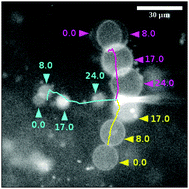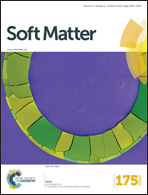Migration of phospholipid vesicles in response to OH− stimuli†
Abstract
We demonstrate migration of phospholipid vesicles in response to a pH gradient. Upon simple micro-injection of a NaOH solution, the vesicles linearly moved to the tip of the micro-pipette and the migration velocity was proportional to the gradient of OH− concentration. Vesicle migration was characteristic of OH− ions and no migration was observed for monovalent salts or nonionic sucrose solutions. The migration of vesicles is quantitatively described by the surface tension gradient model where the hydrolysis of the phospholipids by NaOH solution decreases the surface tension of the vesicle. The vesicles move toward a direction where the surface energy decreases. Thus the chemical modification of lipids produces a mechanical force to drive vesicles.


 Please wait while we load your content...
Please wait while we load your content...